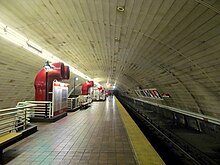Glove Cycle
| Glove Cycle | |
|---|---|
Mags Harries | |
| Year | 1984 |
| Type | Installation art (bronze) |
| Location | Porter station, Cambridge, Massachusetts |
| 42°23′18.65″N 71°07′09.4″W / 42.3885139°N 71.119278°W | |
| Owner | Massachusetts Bay Transportation Authority |
Glove Cycle is a 1984
Sculpture

Glove Cycle is a sculptural installation of 54 separate bronze sculptures of gloves located throughout
Robert O. Boorstin from The Harvard Crimson adds that there are gloves "in piles, gripping rails, pushing imaginary buttons—as a constant image that the passenger follows from one point of the station to another".[4] Mags Harries explains that the gloves she crafted "are anthropomorphic objects with many character possibilities and by their multiplication, take on a life form that might be analogous to the people movement in the subway."[4] Robert O. Boorstin claims that this philosophy and explanation are "somewhat extravagant."[4]
History

Glove Cycle was created as a part of the MBTA and the Cambridge Arts Council's "
Gloves was not the first theme that Harries considered for her subterranean artwork. Initially her concept revolved around bronze tree roots appearing to come through the walls and into the stations. This idea was turned down by the architects of Porter Station for bringing attention to the fact that the station is deep underground. Harries stated, "The whole philosophy of subway stations, it turns out, is to make them seem as un-underground as possible," something the tree roots idea would be the exact opposite of.[3] The next theme she considered was to create a flock of sheep-shaped turnstiles. This concept fell to the wayside as the snow from a blizzard in Boston began to melt. Harries began to find lost gloves emerging from the snow. She said that, "They were wet, compacted, squashed—really beautiful!"[3] These lost items gave her the inspiration for her new sculptural theme, gloves.[3]
Three of the gloves were stolen during the sculpture's first decade by vandals who broke them out of walls.[7]
References
- ^ a b Glove Cycle Archived 2012-04-22 at the Wayback Machine. Mags Harries & Lajos Héder. Retrieved May, 22, 2012.
- ^ Arts on the Line:Porter Square MBTA Station Archived 2011-07-21 at the Wayback Machine. Cambridge Arts Council. 2002. Accessed October 12, 2010
- ^ Smithsonian Magazine. April 01, 1987. Retrieved June 2, 2012.
- ^ a b c Boorstin, Robert O. Take the Red Line ... Please. Artists on the Line at the Carpenter Center through March 9. The Harvard Crimson. February 26, 1979. Retrieved June 2, 2012.
- ^ a b Red Line Northwest Extension Pamphlet page 5. The Davis Square Tiles Project. Accessed October 10, 2010
- ^ Nesbitt, Lois E. Arts on the Line: Art for Public Transit Spaces At the Hayden Gallery, MIT, 160 Memorial Drive, Cambridge Through March 16. Harvard Crimson. February 15, 1980. Accessed May 22, 2012
- ^ Temin, Christine (May 28, 1995). "Keeping art fit to a T". The Boston Globe. pp. B17, B22 – via Newspapers.com.
